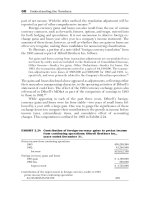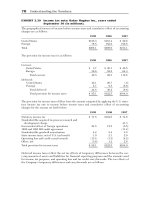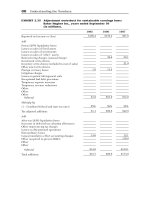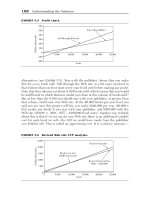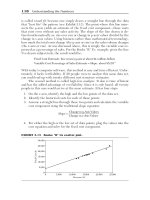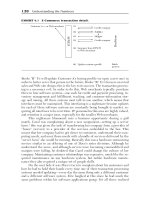Giáo trình Tiếng anh chuyên ngành Kế toán CĐ Nghề Công Nghiệp Hà Nội
Bạn đang xem bản rút gọn của tài liệu. Xem và tải ngay bản đầy đủ của tài liệu tại đây (2.31 MB, 138 trang )
ỦY BAN NHÂN DÂN THÀNH PHỐ HÀ NỘI
TRƯỜNG CAO ĐẲNG NGHỀ CÔNG NGHIỆP HÀ NỘI
Chủ biên:
Hứa Thị Mai Hoa
Đồng tác giả:
Nguyễn Lệ Hằng
Nguyễn Quang Huy
GIÁO TRÌNH
TIẾNG ANH CHUYÊN NGÀNH KẾ TOÁN
ENGLISH FOR ACCOUNTING
Mã số môn học: MH10
HÀ NỘI 2013
1
LỜI NÓI ĐẦU
Giáo trình “TIẾNG ANH CHUYÊN NGÀNH KẾ TOÁN ” được
biên soạn theo chương trình đào tạo nghề kế toán của tổng cục nghề, giảng
dạy cho sinh viên hệ Cao đẳng nghề của trường Cao đẳng Nghề Công
nghiệp Hà Nội. Tuy nhiên, giáo trình này có những ưu điểm nổi bật sau:
Có tính cập nhật mới nhất.
Các thông tin và thông số đưa ra có tính khoa học và độ tin cậy cao.
Có bố cục hợp lý, logic, khoa học.
Có nhiều hoạt động thảo luận cặp, nhóm thông qua các đọa hội thoại.
Các chủ đề bài học có tranh ảnh minh họa, được thiết kế một cách cụ
thể, thiết thực và gắn liền với thực tế.
Vốn từ vựng phong phú.
Vốn kiến thức phù hợp với trình độchung cho đối tượng học sinh
trường nghề.
Để đáp ứng yêu cầu trên các bài trong giáo trình vừa tuân theo
chương trình vừa có những chủ đề gần gũi với sinh viên ngành kế toán. Khi
các em học đến phần tiếng Anh chuyên ngành thì các em cũng đã có những
kiến thức nhất định về nghề cũng như có một số kiến thức tiếng Anh cơ
bản, do đó mục tiêu của giáo trình là:
- Phát triển những kỹ năng như: đọc hiểu, dịch các tài liệu tiếng Anh
chuyên ngành kế toán.
- Phát triển các kỹ năng theo một hệ thống các chủ điểm gắn liền với
các hoạt động chuyên ngành kế toán, đặc biệt phát triển kỹ năng đọc, dịch
hiểu;
- Xây dựng và rèn luyện các kỹ năng học tập ngoại ngữ đồng thời
hình thành và phát triển khả năng độc lập suy nghĩ và sáng tạo trong giao
tiếp bằng tiếng Anh cho sinh viên;
- Đây là giáo trình mang tính chuyên ngành nên tranh ảnh nhiều,
chúng tôi đề nghị giáo trình được in mầu để sinh viên dễ dàng hơn trong
việc hiểu các khái niệm chuyên ngành bằng tiếng Anh thông qua hình ảnh.
Để hoàn thành việc biên soạn giáo trình, chúng tôi luôn được sự giúp
đỡ của các giáo viên trong trường. Chúng tôi xin chân thành cám ơn các
giáo viên tổ môn Tiếng Anh và Kinh Tế của nhà trường đã nhiệt tình giúp
đỡ chúng tôi trong quá trình biên soạn.
2
Chắc chắn giáo trình không tránh khỏi thiếu sót. Chúng tôi mong
nhận được ý kiến đóng góp để giáo trình được chỉnh sửa và ngày càng hoàn
thiện hơn.
Xin trân trọng cám ơn
Hà Nội,ngày 1 tháng 12 năm 2012
Tham gia biên soạn giáo trình
Hứa Thị Mai Hoa - Chủ biên
Nguyễn Lệ Hằng
Nguyễn Quang Huy
3
Tuyên bố bản quyền
Tài liệu này là loại giáo trình nội bộ dùng trong nhà trường
với mục đích làm tài liệu giảng dạy cho giáo viên và học sinh, sinh
viên nên các nguồn thông tin có thể được tham khảo.
Tài liệu phải do trường Cao đẳng nghề Công nghiệp Hà Nội in
ấn và phát hành.
Việc sử dụng tài liệu này với mục đích thương mại hoặc khác
với mục đích trên đều bị nghiêm cấm và bị coi là vi phạm bản
quyền.
Trường Cao đẳng nghề Công nghiệp Hà Nội xin chân thành
cảm ơn các thông tin giúp cho nhà trường bảo vệ bản quyền của
mình.
Địa chỉ liên hệ:
Trường Cao đẳng nghề Công nghiệp Hà Nội.
131 – Thái Thịnh – Đống Đa – Hà Nội
Điện thoại:
(84-4) 38532033
Fax:
(84-4) 38533523
Website: www.hnivc.edu.vn
4
CONTENTS
CONTENTS
PAGE
MAIN CONTENTS
Chương trình môn học
7
Unit 1: Market Economy
12
Unit 2: Macroeconomics and Microeconomics
18
Unit 3: Supply and Demand
24
Unit 4: Money and its functions
29
Unit 5: Bank and business
36
Unit 6: Marketing and Analysis of market opportunities
45
Unit 7: Pricing
53
Unit 8: Finance
62
Unit 9: Taxation
67
Unit 10: Insurance
74
Unit 11: Management of Working capital
77
Unit 12: Accounting – the Balance sheet
82
Unit 13: The Income statement
89
Unit 14: The Cash flow statement
94
Unit 15: The role of Auditor
98
APPENDIX
Appendix 1
101
Appendix 2
102
Appendix 3
104
Appendix 4
106
5
Appendix 5
108
Appendix 6
109
Appendix 7
110
Appendix 8
116
Appendix 9
118
Appendix 10
119
Appendix 11
121
Appendix 12
123
Appendix 13
126
Appendix 14
128
Appendix 15
133
Appendix 16
136
REFERENCE
138
6
CHƯƠNG TRÌNH MÔN HỌC
TIẾNG ANH CHUYÊN NGÀNH KẾ TOÁN
Mã số môn học: MH 10
Thời gian của môn học: 60 giờ - (Lý thuyết: 40 giờ ; Thực hành: 20 giờ)
I. VỊ TRÍ, TÍNH CHẤT CỦA MÔN HỌC:
- Vị trí: Là một trong những môn học chuyên ngành được bố trí giảng dạy
sau khi đã học xong các môn học chung.
- Tính chất: Là một môn học bắt buộc, với vai trò công cụ tạo điều kiện cho
đất nước hoà nhập với cộng đồng quốc tế và khu vực, hoà nhập kinh tế thị
trường thế giới, tiếp cận với những thông tin khoa học kỹ thuật và các nền
văn hoá trên thế giới, đồng thời giới thiệu nền văn hoá Việt Nam với thế
giới giúp sinh viên nâng cao chuyên môn thông qua đọc, dịch tài liệu
chuyên ngành bằng Tiếng Anh.
II. MỤC TIÊU MÔN HỌC:
- Phát triển những kỹ năng như: đọc hiểu, dịch các tài liệu tiếng Anh
chuyên ngành tài chính kế toán.
- Đọc hiểu được các sổ sách, biểu bảng.
- Đọc hiểu các tài liệu đọc thêm bừng tiếng Anh và tóm tắt nội dung chính
của tài liệu.
- Nắm được vốn từ vựng và ngữ pháp cơ bản của tiếng Anh chuyên ngành
tài chính kế toán.
III. NỘI DUNG MÔN HỌC:
1. Nội dung tổng quát và phân phối thời gian:
Số
TT
Thời gian (giờ)
Tên chương, mục
Tổng
Lý
số
thuyết
Thực Kiểm
hành tra
I
Marketing economy
Vocabulary
Reading
Comprehension
Word- study
4
3
1
II
Microeconomics and
Macroeconomics
4
3
1
7
Vocabulary
Reading
Comprehension
Word- study
III
Supply and demand
Vocabulary
Reading
Comprehension
Word- study
4
3
1
IV
Money and its functions
Vocabulary
Reading
Comprehension
Word- study
4
3
1
V
Banks and Business
Vocabulary
Reading
Comprehension
Word- study
4
3
1
Test 1
1
VI
Marketing,
Analysis
marketing opportunities
Vocabulary
Reading
Comprehension
Word- study
VII
VIII
of
1
3
2
1
Pricing
Vocabulary
Reading
Comprehension
Word- study
3
2
1
Finance
Vocabulary
Reading
4
2
2
8
Comprehension
Word- study
IX
Taxation
Vocabulary
Reading
Comprehension
Word- study
4
3
1
X
Insurance
Vocabulary
Reading
Comprehension
Word- study
3
2
1
Test 2
1
1
XI
Management
of
capital
Vocabulary
Reading
Comprehension
Word- study
working
4
3
1
XII
Accounting , the balance sheet
Vocabulary
Reading
Comprehension
Word- study
4
2
2
XIII
An income statement
Vocabulary
Reading
Comprehension
Word- study
4
2
2
Test 3
1
A cash flow statement
Vocabulary
Reading
Comprehension
3
XIV
9
1
2
1
Word- study
XV
The role of Auditors
Vocabulary
Reading
Comprehension
Word- study
3
2
1
EXAM
Total
60
2. Yêu cầu về đánh giá hoàn thành môn học:
* Về kiến thức:
+ Sử dụng được những thuật ngữ chuyên ngành liên quan đến tài chính và
kế toán.
+ Sử dụng một số cấu trúc ngữ pháp hay dùng trong tiếng Anh
chuyên ngành như: thể bị động, mệnh đề quan hệ, câu mong ước, câu điều
kiện, tính từ so sánh, liên từ, câu mục đích, giới từ…
* Về kỹ năng:
Đọc, hiểu và dịch được một số tài liệu liên quan đến chuyên ngành
tài chính và kế toán từ Tiếng Anh sang Tiếng Việt.
* Về thái độ:
Người học có thái độ học tập nghiêm túc, cố gắng tiếp thu kiến thức
hiệu quả nhất để sau này vận dụng kiến thức đã học vào dịch tài liệu
chuyên ngành nhằm nâng cao chuyên môn trong công việc.
* Phạm vi từ vựng, kiến thức Tiếng Anh chuyên ngành cần kiểm tra sau
khi hoàn thành môn học:
+ Kinh tế thị trường, kinh tế vĩ mô, kinh tế vi mô
+ Cung cầu
+ Tiền, ngân hàng và doanh nghiệp
+ Thị trường vốn
+ Thuế
+ Bảo hiểm
+ Kế toán, báo cáo tài chính
+ Kiểm toán
* Phương pháp kiểm tra đánh giá sau khi kết thúc môn học:
10
+ Trắc nghiệm
+ Tự luận.
11
UNIT 1: THE MARKET ECONOMY
READING COMPREHENSION
Planned economy: A system whereby the structure of the market is
deliberately planned by the state, in which production and consumption
quotas are fixed beforehand and where there is no real competition between
industrial or commercial organizations. In the Soviet model, for instance,
all the means of production and the channels are state controlled. Private
ownership does not exist in this field.
In practice, there is wide gap between the theoretical model and
economy realities: the so- called market economies rely more and more on
Government planning and intervention, whereas in planned economies,
such capitalistic notions as profit tend to be reintroduced.
Free market economy: An economic system in which the market –
that is the relation between producers and consumers, buyers and sellers,
investors and workers, management and labour – is supposed to be
regulated by the law of supply and demand. Business firms are supposed to
complete freely, and any attempt at hindering free competition (‘restrictive
practices’) is punishable by law.
Direct government intervention is theoretically ruled out although
the government will influence the economic situation through its fiscal and
budgetary policies.
Mixed economy: An economic system in which some goods and
services are produced by the government and some by private enterprise. It
12
lies between a command economy and a complete laissez- faire economy.
In practice, most economies are mixed: the significant feature is whether an
economy is moving towards or away from a more laissez – faire situation.
VOCABULARY
Free market economy:
inventor(n)/investor:
management (n):
manage to do smt
labour ;labor ['leibə] (n)
suppose (v):
supply (n):
supply smt for smb
demand (n):
attempt (v):
hinder (v):
restrictive (adj):
intervention(n):
fiscal (adj):
budgetary (adj):
planned economy:
deliberately(adj):
quotas (n):
beforehand (adv):
commercial (adj):
ownership (n):
reality [ri:'æliti] (n):
so- called (adj):
rely (v): ( + on, upon)
notion ['nou∫n] (n):
mixed economy (n):
enterprise (n):
laissez- faire (n):
Free market economy
người phát minh, người sáng chế
sự trông nom, sự quản lý
cố gắng làm gì
lao động.
cho là; tin rằng; nghĩ rằng
sự cung cấp; sự được cung cấp
sự đòi hỏi, sự yêu cầu; nhu cầu
nỗ lực làm cái gì; thử làm cái gì
cản trở, gây trở ngại
hạn chế, giới hạn
sự xen vào, sự can thiệp
(thuộc) công khố; (thuộc) tài chính
(thuộc) ngân sách
nền kinh tế có kế hoạch tập trung
có suy nghĩ cân nhắc; thận trọng
phần, chỉ tiêu
sẵn sàng; trước; sớm hơn
thuộc về hoặc dành cho thương mại
quyền sở hữu
sự thực; thực tế; thực tại; cái có thật
cái gọi là
tin vào, tin cậy vào, tin tưởng vào
ý niệm, khái niệm
hệ thống kinh tế hợp doanh
(từ Mỹ,nghĩa Mỹ) tổ chức kinh
doanh, hãng, xí nghiệp
chính sách để mặc tư nhân kinh
doanh; chính sách tự do kinh
13
doanh; sự không can thiệp vào việc
người khác
COMPREHENSION
Using the information in the text, answer the questions below:
What is market economy?
What is planned economy?
What are differences between Market economy and Planned economy?
What is mixed economy?
WORD-STUDY
Work with your friends; find out all the words in the picture below
and research their meaning. Then compare your results to other groups.
Fill each of the numbered blanks in the following passage. Use only
one word from the box in each space:
Principle the
anything
how
at
both
what
14
for
issues
training
Economy is ……………… (1) study of how individuals and nations
make choices about how to use scare resources to fill their needs and wants.
A resource is ………….. (2) that people can use to make or obtain
…………..(3) they need or want. You may be asking yourself …………..
(4) this point how economics will help you, a student. Also, you may be
wandering how a scare resource is a problem ……………(5) a nation like
the United State that has such abundant resources.
It may surprise you to know that many of the decisions you will face
as a citizen deal with ……………. (6) the United States should use its
resources. Learning economic ………(7) can help you make decisions
about candidates for political office, political social………………(8), and
the goals the United States should set for itself, such as how to spend
government revenues. Many people are familiar with the benefits of
government programs such as job ……… (9) and Medicare, but how many
people are aware of the costs of this programs? Economics can help you to
understand ……….(10) costs and benefits and, therefore, help you to make
better decisions.
FURTHER READING
1.“ĐỔI MỚI” – REFORM PERIOD
The economy
of
Vietnam is
a
developing planned
economy and market economy. Since the mid-1980s, through the "Đổi
Mới" reform period, Vietnam has made a shift from a highly-centralized
planned economy to a socialist-oriented market economy which use both
directive and indicative planning (see Five-Year Plans of Vietnam). Over
15
that period, the economy has experienced rapid growth. Nowadays,
Vietnam is in a period of being integrated into the global economy. Almost
all Vietnamese enterprises are SMEs. Vietnam has become a leading
agricultural exporter and served as an attractive destination for foreign
investment in Southeast Asia.
In 2011, the nominal GDP reached $121.6 billion, with
nominal GDP per capita of $1328.60. According to a forecast in December
2005 by Goldman Sachs, Vietnamese economy will become the 35th
largest economy in the world with nominal GDP of $ 436 billion and
nominal GDP per capita of 4,357 USD by 2025. According to a forecast by
the PricewaterhouseCoopers in 2008, Vietnam may be the fastest growing
of emerging economies by 2025, with a potential annual growth rate of
about 10% in real dollar terms, which would increase the size of the
economy to 70% of the size of the UK economy by 2050.
2. CHARACTERISTICS OF A MARKET ECONOMY PRIVATE
PROPERTY
Labor resources, natural resources, capital resources (e.g., equipment and
buildings), and the goods and services produced in the economy are largely
owned by private individuals and private institutions rather than by
government. This private ownership combined with the freedom to
negotiate legally binding contracts permits people, within very broad limits,
to obtain and use resources as they choose.
FREEDOM OF ENTERPRISE AND CHOICE
Private entrepreneurs are free to obtain and organize resources in the
production of goods and services and to sell them in markets of their
choices. Consumers are at liberty to buy that collection of goods and
services that best satisfies their economic wants. Workers are free to seek
any jobs for which they are qualified.
MOTIVE OF SELF-INTEREST
The "Invisible Hand" that is the driving force in a market economy is each
individual promoting his or her self-interest. Consumers aim to get the
greatest satisfaction from their budgets; entrepreneurs try to achieve the
highest profits for their firms; workers want the highest possible wages and
16
salaries; and owners of property resources attempt to get the highest
possible prices from the rent and sale of their resources.
COMPETITION
Economic rivalry means that buyers and sellers are free to enter or leave
any market and that there are buyers and sellers acting independently in the
marketplace. It is competition, not government regulation, that diffuses
economic power and limits the potential abuse of that power by one
economic unit against another as each attempts to further its own selfinterest.
SYSTEM OF MARKETS AND PRICES
Markets are the basic coordinating mechanisms in our type of economy, not
central planning by government. A market brings buyers and sellers of a
particular good or service into contact with one another. The preferences of
sellers and buyers are registered on the supply and demand sides of various
markets, and the outcome of these choices is a system of product and
resource prices. These prices are guideposts on which participants in
markets make and revise their free choices in furthering their self-interests.
LIMITED GOVERNMENT
A competitive market economy promotes the efficient use of its resources.
As a self-regulating and self-adjusting economy, no significant economic
role for government is necessary. However, a number of limitations and
undesirable outcomes associated with the market system result in an active,
but limited economic role for government.
17
UNIT 2: MACROECONOMICS
AND MICROECONOMICS
I. READING
1. What is economic?
The Economist's Dictionary of Economics defines economics as
"The study of the production, distribution and consumption of wealth in
human society."
2. What is macroeconomic?
The field of economics that studies the behavior of the aggregate
economy. Macroeconomics examines economy-wide phenomena such as
changes in unemployment, national income, rate of growth, gross domestic
product, inflation and price levels.
3. What is microeconomic?
18
The branch of economics that analyzes the market behavior of
individual consumers and firms in an attempt to understand the decisionmaking process of firms and households. It is concerned with the
interaction between individual buyers and sellers and the factors that
influence the choices made by buyers and sellers. In particular,
microeconomics focuses on patterns of supply and demand and the
determination of price and output in individual markets (e.g. coffee
industry).
II. VOCABULARY
Resource (n):
nguồn lực, tài nguyên
Factor (n):
nhân tố, yếu tố
Aggregate (n):
tập hợp lại, kết hợp lại, gộp lại
Phenomenon (n):
hiện tượng
Unemployment (n):
tình trạng thất nghiệp
National income:
thu nhập quốc gia
Rate of growth:
tỷ lệ tăng trưởng
Inflation (n):
sự lạm phát
Price level:
mức giá
Analyze (v):
phân tích
Behavior (human behavior, market behavior…) (n): hành vi
Individual (adj)
cá nhân, cá thể, đơn lẻ
Interaction (n):
tính tương tác, sự tương tác
Influence (n):
ảnh hưởng
Seller (n):
người bán
Buyer (n):
người mua
Nation wide:
trên phạm vi toàn quốc
Individual market:
thị trường riêng lẻ
Supply and demand:
cung và cầu
III. READING COMPREHENSION
THE RELATIONSHIP
BETWEEN MACROECONOMICS & MICROECONOMICS
Microeconomics
19
Those who have studied Latin know that the prefix “micro-“ means
“small,” so it shouldn’t be surprising that microeconomics is the study of
small economic units. The field of microeconomics is concerned with
things like:
Consumer decision making and utility maximization
Firm production and profit maximization
Individual market equilibrium
Effects of government regulation on individual markets
Externalities and other market side effects
Macroeconomics
Macroeconomics can be thought of as the “big picture” version of
economics. Rather than analyzing individual markets, macroeconomics
focuses on aggregate production and consumption in an economy. Some
topics that macroeconomists study are:
The effects of general taxes such as income and sales taxes on output
and prices
The causes of economic upswings and downturns
The effects of monetary and fiscal policy on economic health
How interest rates are determined
Why some economies grow faster than others
The Relationship between Microeconomics and Macroeconomics
There is an obvious relationship between microeconomics and
macroeconomics in that aggregate production and consumption levels are
the result of choices made by individual households and firms, and some
macroeconomic models explicitly make this connection.
Most of the economic topics covered on television and in
newspapers are of the macroeconomic variety, but it’s important to
remember that economics is about more than just trying to figure out when
the economy is going to improve and what the Fed is doing with interest
rates.
IV. COMPREHENSION
Use the knowledge you have studied to answer the following
questions
Macroeconomic:
20
1. What is the importance of macroeconomics?
2. What does macroeconomics study?
3. What does fiscal policy deal with?
4. What are 4 main areas that macroeconomics focuses on?
5. What are 4 tools of macroeconomics policy?
Microeconomic:
1. What does microeconomics deal with?
2. What does microeconomics focus on?
3. Does microeconomics analyze what influences the prices of
particular goods?
4. In microeconomics what are supply and demand analyses considered
to be?
* The instructions are available in Appendix 1.
V. WORD STUDY
1. Work with your partners and use your knowledge to explain the cause
and effect story in the following picture
2. Choose the best answer to fill in the blank
1. Inflation that's out of control = _____________________inflation
runaway
renegade
rebel
21
2. Barack Obama said that the United States has a plan to bring the deficit
_______________________ (= decrease the deficit) once the economic
crisis has been resolved.
lower
down
downward
3. __________________(= very high) deficits could spark (= cause)
inflation or a sudden drop in the value of the U.S. dollar.
Soaring
Flying
Cruising
4. Most analysts believe the U.S. is __________(= ready, just about) to
make steady progress on this issue.
standing
poised
almost
5. to __________ the whole system = to put the whole system at risk
jettison
germinate
jeopardize
6. to stimulate economic growth = to ___________ economic growth
stifle
stretch
spur
7. He doesn't think that current economic conditions will continue to ____.
(= he thinks that the current economic conditions will change)
prevail
lag on
drag out
22
8. The worst that can possibly happen = the worst ______________
case study
case scenario
take on things
9. You can't keep taking these things _________________________. (=
you can't keep assuming that these things will always be there)
by decree
in transit
for granted
10. The new regulations should prevent banks from _____________. (=
from going bankrupt)
failing
falling
keeping afloat
23
UNIT 3: SUPPLY AND DEMAND
I. READING
1. Definition of 'Supply'
A fundamental economic concept that describes the total amount of a
specific good or service that is available to consumers. Supply can relate to
the amount available at a specific price or the amount available across a
range of prices if displayed on a graph. This relates closely to the demand
for a good or service at a specific price; all else being equal, the supply
provided by producers will rise if the price rises because all firms look to
maximize profits.
2. Definition of 'Demand'
An economic principle that describes a consumer’s desire and
willingness to pay a price for a specific good or service. Holding all other
factors constant, the price of a good or service increases as its demand
increases and vice versa.
II. VOCABULARY
Demand (n):
Supply (n):
Separate (v):
Real (adj):
Equilibrium (adj):
Shortage (n)
cầu, nhu cầu
cung, nguồn cung
tách biệt, riêng biệt
thực, tính thực tế
tính cân bằng
thiếu hụt
24
Surplus (n):
Pressure on (v):
Force (n):
Balance (v):
Quantity (n):
Price (n):
Curve (n):
Reflect (v):
Certain price:
Upward slope:
Downward slope:
Illustrate (v):
Negative relationship:
Opportunity cost:
Forgo (v):
Increase (v):
Decrease (v):
Revenue (n):
Chart (n):
Desire (n):
Willingness (n):
thặng dư, dư thừa
áp lực
lực lượng
cân đối.
số lượng
giá cả
đường cong
phản chiếu, phản ánh
giá cố định
đường dốc lên
đường dốc xuống
minh họa
mối quan hệ tỉ lệ nghịch
chi phí cơ hội
thôi, bỏ, kiêng
tăng lên
giảm xuống
thu nhập, doanh thu
đồ thị, biểu đồ
sự mong muốn, sự khao khát
sự bằng lòng, sẵn sàng, sốt sắng
III. READING COMPREHENSION
THE RELATIONSHIP BETWEEN SUPPLY AND DEMAND
25
